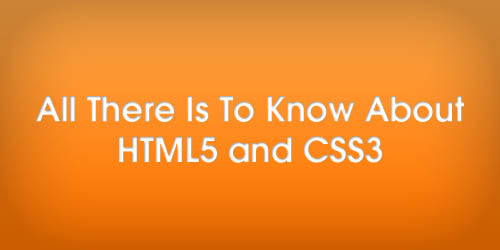
HTML5 has definitely become a trend alongside its lil’ brother CSS3 because of their functions and utilities which makes them the next best thing in web design. Better even than Flash, maybe, in some situations. Being the next best thing will not determine you to use it, but the fact that it introduces and enhances a wide range of features including form controls, APIs, multimedia, structure, and semantics will do. The most important thing for you to know is that you can’t learn it just by reading, you have to work with it, step by step, using these new techniques from the tutorials that I’m bringing you here and by the time HTML5 and CSS3 properties will be supported on every browser you’ll be a rockstar coder.
Preparing for CSS3 and HTML5
Get Ready for HTML 5
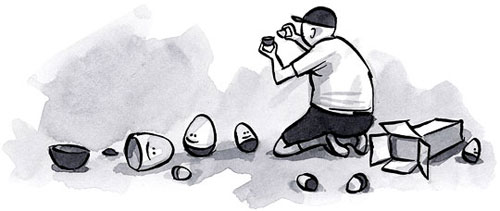
With support in Chrome, Firefox 3.5, Opera, and Safari, HTML 5 is coming at you like a runaway train. Here are some suggestions to help you prepare to get on board rather than be left at the platform or tied to the tracks.

With support in Chrome, Firefox 3.5, Opera, and Safari, HTML 5 is coming at you like a runaway train. Here are some suggestions to help you prepare to get on board rather than be left at the platform or tied to the tracks.
The Basics of CSS3
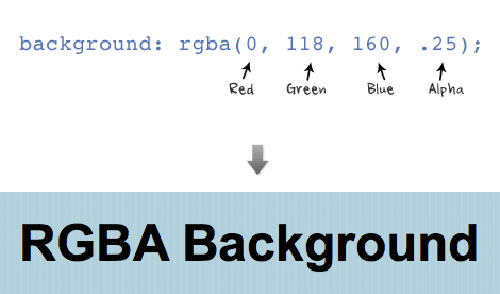
Well, here is a post on the basics of the new properties: text-shadow, box-shadow, and border-radius. These CSS3 properties are commonly used to enhance layout and good to know.

Well, here is a post on the basics of the new properties: text-shadow, box-shadow, and border-radius. These CSS3 properties are commonly used to enhance layout and good to know.
Why HTML5 is worth your time
The debate over HTML5 vs. Flash is great for comments and page views, but all that chatter obscures the bigger issue: Should developers and designers invest in HTML5?
The debate over HTML5 vs. Flash is great for comments and page views, but all that chatter obscures the bigger issue: Should developers and designers invest in HTML5?
RGBa vs Opacity: The Difference Explained
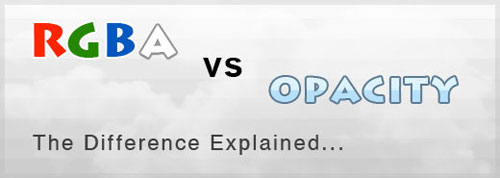
To be able to effectively handle the alpha transparency or opacity of a particular element purely using CSS/HTML was the dream of any web designer. Because, with alpha transparency or opacity they can make visually more beautiful and easily maintainable websites with less effort. Now with CSS3 we can achieve these using properties such as RGBa and Opacity.

To be able to effectively handle the alpha transparency or opacity of a particular element purely using CSS/HTML was the dream of any web designer. Because, with alpha transparency or opacity they can make visually more beautiful and easily maintainable websites with less effort. Now with CSS3 we can achieve these using properties such as RGBa and Opacity.
10 Things CSS3 and HTML5 will teach us
While we are all squirming in our seats waiting for the official release and support of HTML5 and CSS3, I’d thought I’d share with you some interesting things about both. We can all look at a boring list of the features of both, but they don’t really tell us how front end development is going to change. Although I’m super excited about how much easier it’s going to make my coding, I’m also somewhat nervous as there’s going to be a HUGE learning curve (especially for CSS3), even if it’s just to our coding habits. Here are 10 great things that both CSS3 and HTML5 are going to teach us very soon.
While we are all squirming in our seats waiting for the official release and support of HTML5 and CSS3, I’d thought I’d share with you some interesting things about both. We can all look at a boring list of the features of both, but they don’t really tell us how front end development is going to change. Although I’m super excited about how much easier it’s going to make my coding, I’m also somewhat nervous as there’s going to be a HUGE learning curve (especially for CSS3), even if it’s just to our coding habits. Here are 10 great things that both CSS3 and HTML5 are going to teach us very soon.
html5test.com
The HTML5 test score is only an indication of how well your browser supports the upcoming HTML5 standard. It does not try to test all of the new features offered by HTML5, nor does it try to test the functionality of each feature it does detect. Despite these shortcomings we hope that by quantifying the level of support users and web developers will get an idea of how hard the browser manufacturers work on improving their browsers and the web as a development platform.
The HTML5 test score is only an indication of how well your browser supports the upcoming HTML5 standard. It does not try to test all of the new features offered by HTML5, nor does it try to test the functionality of each feature it does detect. Despite these shortcomings we hope that by quantifying the level of support users and web developers will get an idea of how hard the browser manufacturers work on improving their browsers and the web as a development platform.
css3.info
CSS3 is the new kid in the stylesheet family. It offers exciting new possibilities to create an impact with your designs, allows you to use more diverse style sheets for a variety of occasions and lots more. We created this site because we want to share our experiences of CSS3 with you, and want nothing more than to simply be the biggest online resource covering CSS3.
CSS3 is the new kid in the stylesheet family. It offers exciting new possibilities to create an impact with your designs, allows you to use more diverse style sheets for a variety of occasions and lots more. We created this site because we want to share our experiences of CSS3 with you, and want nothing more than to simply be the biggest online resource covering CSS3.
Tutorials, tips and techniques
CSS3 Animation
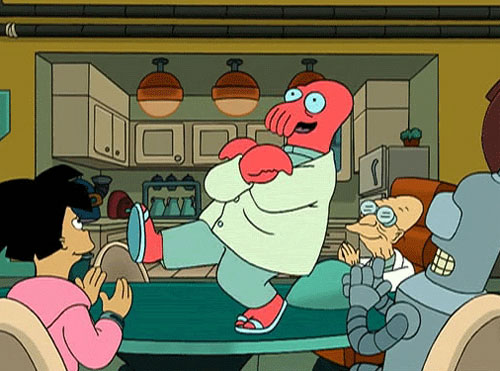
After looking at another ‘Test you skills’ quiz on Sitepoint CSS – Test Your CSS Skills Number 32 and some work by ‘drjochum’ and ‘YuriKolovsky’, I have come up with this demonstration which makes use of of the CSS3 selector ‘+’ (next sibling) to make ‘next’ elements move to the top of the pile when either hovering or clicking the ‘previous’ element.

After looking at another ‘Test you skills’ quiz on Sitepoint CSS – Test Your CSS Skills Number 32 and some work by ‘drjochum’ and ‘YuriKolovsky’, I have come up with this demonstration which makes use of of the CSS3 selector ‘+’ (next sibling) to make ‘next’ elements move to the top of the pile when either hovering or clicking the ‘previous’ element.
CSS3 animations and their jQuery equivalents
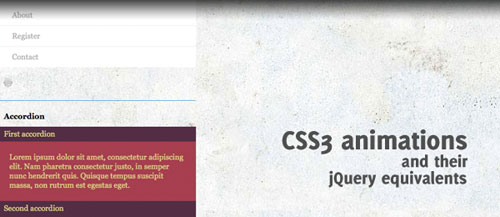
At the same time, I wanted to see if those animations with CSS3 could be created with jQuery too (especially for those browser that don’t support CSS3 animations yet). So today, I present you Five examples of CSS3 animations and their jQuery equivalents.

At the same time, I wanted to see if those animations with CSS3 could be created with jQuery too (especially for those browser that don’t support CSS3 animations yet). So today, I present you Five examples of CSS3 animations and their jQuery equivalents.
Pure CSS3 Animated AT-AT Walker from Star Wars

In this article we’ll quickly walk-through the process of creating a CSS3 animation of an AT-AT Walker from The Empire Strikes Back. We’ll start off by reviewing some CSS3 properties that made this animation possible. Then, follow up with a list of the sections required to construct the AT-AT and the CSS3 code to move each section. I wont go too deep into the explanations of CSS3. There are various resources online to get you up to speed with CSS3.

In this article we’ll quickly walk-through the process of creating a CSS3 animation of an AT-AT Walker from The Empire Strikes Back. We’ll start off by reviewing some CSS3 properties that made this animation possible. Then, follow up with a list of the sections required to construct the AT-AT and the CSS3 code to move each section. I wont go too deep into the explanations of CSS3. There are various resources online to get you up to speed with CSS3.
11 Classic CSS Techniques Made Simple with CSS3
We’ve all had to achieve some effect that required an extra handful of divs or PNGs. We shouldn’t be limited to these old techniques when there’s a new age coming. This new age includes the use of CSS3. In today’s tutorial, I’ll show you eleven different time-consuming effects that can be achieved quite easily with CSS3.
We’ve all had to achieve some effect that required an extra handful of divs or PNGs. We shouldn’t be limited to these old techniques when there’s a new age coming. This new age includes the use of CSS3. In today’s tutorial, I’ll show you eleven different time-consuming effects that can be achieved quite easily with CSS3.
Design & Code a Cool iPhone App Website in HTML5
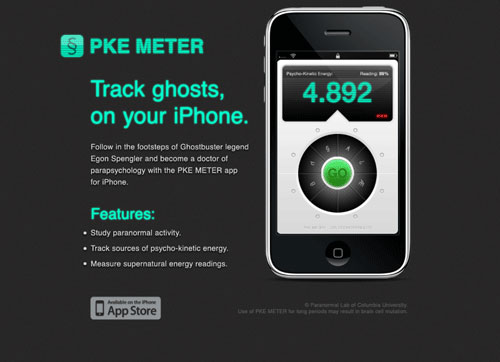
HTML5 is definitely the flavor of the month, with everyone in the design community getting excited about its release. In this tutorial we’ll get a taste of what’s to come by building a cool iPhone app website using a HTML5 structure, and visual styling with some CSS3 effects.

HTML5 is definitely the flavor of the month, with everyone in the design community getting excited about its release. In this tutorial we’ll get a taste of what’s to come by building a cool iPhone app website using a HTML5 structure, and visual styling with some CSS3 effects.
CSS code structure for HTML 5: some useful guidelines
In this post I want to illustrate some useful guidelines about how to implement a well organized CSS code structure in view of introduction of HTML 5 markup language. They are not general rules but simple suggestions you can follow in order to improve the readability, manageability, and general organization of CSS code. These suggestions are especially useful if you have to work on complex CSS files that otherwise can be difficult to manage.
In this post I want to illustrate some useful guidelines about how to implement a well organized CSS code structure in view of introduction of HTML 5 markup language. They are not general rules but simple suggestions you can follow in order to improve the readability, manageability, and general organization of CSS code. These suggestions are especially useful if you have to work on complex CSS files that otherwise can be difficult to manage.
CSS3 pseudo-class selector emulation for Internet Explorer 5.5 – 8
ie-css3.js allows Internet Explorer to identify CSS3 pseudo-class selectors and render any style rules defined with them. Simply include the script in your pages and start using these selectors in your style sheets — they’ll work in IE!
ie-css3.js allows Internet Explorer to identify CSS3 pseudo-class selectors and render any style rules defined with them. Simply include the script in your pages and start using these selectors in your style sheets — they’ll work in IE!
Create a Letterpress Effect with CSS Text-Shadow
The letterpress effect is becoming hugely popular in web design, and with a couple of modern browsers now showing support for the text-shadow CSS3 property it’s now simple and easy to create the effect with pure CSS.
The letterpress effect is becoming hugely popular in web design, and with a couple of modern browsers now showing support for the text-shadow CSS3 property it’s now simple and easy to create the effect with pure CSS.
CSS3 Gradient Buttons
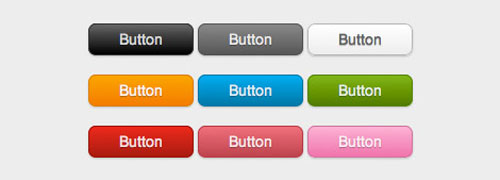
Today I’m going to show you how to put the CSS gradient feature in a good practical use. Check out my demo to see a set of gradient buttons that I have created with just CSS (no image or Javascript). The buttons are scalable based on the font-size. The button size can be easily adjusted by changing the padding and font-size values. The best part about this method is it can be applied to any HTML element such as div, span, p, a, button, input, etc.

Today I’m going to show you how to put the CSS gradient feature in a good practical use. Check out my demo to see a set of gradient buttons that I have created with just CSS (no image or Javascript). The buttons are scalable based on the font-size. The button size can be easily adjusted by changing the padding and font-size values. The best part about this method is it can be applied to any HTML element such as div, span, p, a, button, input, etc.
How To Create a Pure CSS Polaroid Photo Gallery
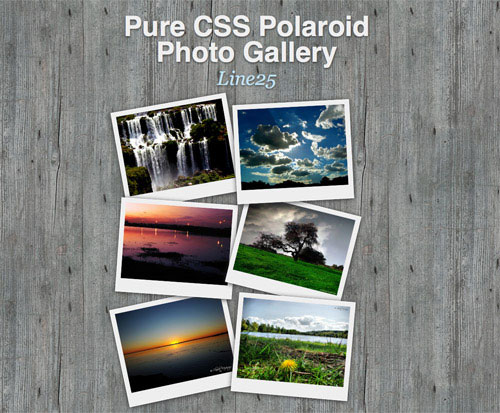
Magical things can be done by combining various CSS properties, especially when some of the new CSS3 tricks are thrown into the mix. Let’s take a look at building a cool looking stack of Polaroid photos with pure CSS styling.

Magical things can be done by combining various CSS properties, especially when some of the new CSS3 tricks are thrown into the mix. Let’s take a look at building a cool looking stack of Polaroid photos with pure CSS styling.
CSS3 Transforms & @font-face Experiment
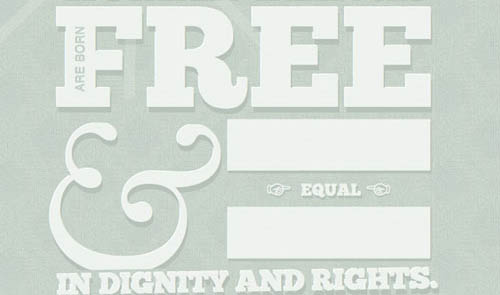
This is the first of what I hope are number of experiments I plan on working on over the next few months, all in an effort to get acquainted with some of the new CSS3 features out in the wild that seem to be gaining some traction.

This is the first of what I hope are number of experiments I plan on working on over the next few months, all in an effort to get acquainted with some of the new CSS3 features out in the wild that seem to be gaining some traction.
5 Simple, But Useful CSS Properties
This post is about 5 useful CSS properties that you should be very familiar with, but will most likely rarely use. I’m not talking about the new fancy CSS3 properties. I’m referring to the old CSS2 properties such as: clip, min-height, white-space, cursor, and display that are widely supported by all browsers.
This post is about 5 useful CSS properties that you should be very familiar with, but will most likely rarely use. I’m not talking about the new fancy CSS3 properties. I’m referring to the old CSS2 properties such as: clip, min-height, white-space, cursor, and display that are widely supported by all browsers.
CSS3 Dropdown Menu
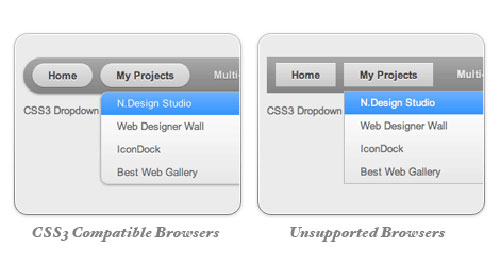
While I was coding the Notepad theme, I’ve learned some new CSS3 features and now I would like to share it with you. View the demo to see a Mac-like multi-level dropdown menu that I’ve created using border-radius, box-shadow, and text-shadow. It renders perfect on Firefox, Safari and Chrome. The dropdown also works on non-CSS3 compitable browsers such as IE7+, but the rounded corners and shadow will not be rendered.

While I was coding the Notepad theme, I’ve learned some new CSS3 features and now I would like to share it with you. View the demo to see a Mac-like multi-level dropdown menu that I’ve created using border-radius, box-shadow, and text-shadow. It renders perfect on Firefox, Safari and Chrome. The dropdown also works on non-CSS3 compitable browsers such as IE7+, but the rounded corners and shadow will not be rendered.
HTML5 Website Layout Tutorials and Inspiration
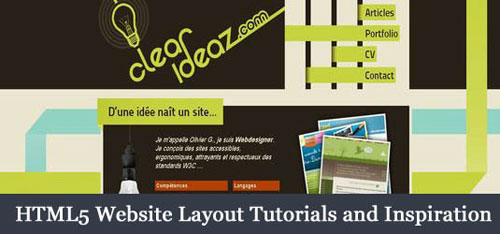
In webdevelopment you have to be in touch with latest technologies, if you really want to be on top. Now HTML5 is new its the fundamental language for web, so we all need to learn it thats why we have collected some tutorials on coding a layout with HTML5 and CSS3.

In webdevelopment you have to be in touch with latest technologies, if you really want to be on top. Now HTML5 is new its the fundamental language for web, so we all need to learn it thats why we have collected some tutorials on coding a layout with HTML5 and CSS3.
Create An Elegant Website With HTML 5 And CSS3

I’m sure that who chooses to work as web designer makes a choice of heart, a choice of love. He/she decides to bet any given day on his creativity and his ability of producing an idea and of making it tangible, visible and perceptible for all. These crazy men have my respect. But, also when the creative side is very important for a work, there exists a logical (and technical) part in all creative process.

I’m sure that who chooses to work as web designer makes a choice of heart, a choice of love. He/she decides to bet any given day on his creativity and his ability of producing an idea and of making it tangible, visible and perceptible for all. These crazy men have my respect. But, also when the creative side is very important for a work, there exists a logical (and technical) part in all creative process.
Editable CSS3 Image Gallery
We build a pretty typical image gallery design pattern, a grid of images that pop up larger when clicked. But this image gallery page makes use of hot semantic HTML5 markup, loads of visual treats with CSS3 and jQuery, and made editable through the CMS PageLime. Quick reminder, the demo is awesome-est in a WebKit browser (Safari or Chrome).
We build a pretty typical image gallery design pattern, a grid of images that pop up larger when clicked. But this image gallery page makes use of hot semantic HTML5 markup, loads of visual treats with CSS3 and jQuery, and made editable through the CMS PageLime. Quick reminder, the demo is awesome-est in a WebKit browser (Safari or Chrome).
Using Rounded Corners with CSS3

As CSS3 gets closer to becoming the new standard for mainstream design, the days of rounded corners through elaborate background images is fading. This means less headache and time spent working out alternatives for each browser.

As CSS3 gets closer to becoming the new standard for mainstream design, the days of rounded corners through elaborate background images is fading. This means less headache and time spent working out alternatives for each browser.
CSS3 Speech Bubble
Just to show the concept i decided to make a speech bubble with a little pointer out of only html and css3.
Just to show the concept i decided to make a speech bubble with a little pointer out of only html and css3.
Use CSS3 to Create a Dynamic Stack of Index Cards
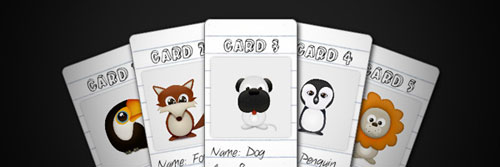
We will create a dynamic stack of index cards solely with HTML and CSS3 and use such CSS3 features as transform and transition (for the dynamic effects) and @font-face, box-shadow and border-radius (for the styling).

We will create a dynamic stack of index cards solely with HTML and CSS3 and use such CSS3 features as transform and transition (for the dynamic effects) and @font-face, box-shadow and border-radius (for the styling).
3D Cube using new CSS transformations
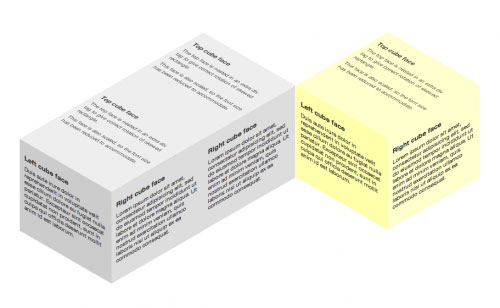
The impression of a three dimensional cube can be created using modern CSS techniques, without the need for JavaScript, imagery, canvas or SVG. Using the proprietary transform property to skew and rotate shaded rectangles, individual cube faces can combine to form a 3D object. Currently only supported in recent WebKit and Gecko based browsers, most importantly Firefox 3.5+ -moz-transform and Safari 3.2+ -webkit-transform.

The impression of a three dimensional cube can be created using modern CSS techniques, without the need for JavaScript, imagery, canvas or SVG. Using the proprietary transform property to skew and rotate shaded rectangles, individual cube faces can combine to form a 3D object. Currently only supported in recent WebKit and Gecko based browsers, most importantly Firefox 3.5+ -moz-transform and Safari 3.2+ -webkit-transform.
5 CSS3 Design Enhancements That You Can Use Today
Cascading Style Sheets (CSS) is the language of Web design, and the next generation of CSS design properties are just chomping at the bit to be released.
Are you eager to start using them, but don’t know where to start?
Although many of the new properties are not yet “official”, some browsers have already implemented many of the features of the coming CSS Level 3 specifications.
The problem is that many browsers—most notably Internet Explorer—have not.
Cascading Style Sheets (CSS) is the language of Web design, and the next generation of CSS design properties are just chomping at the bit to be released.
Are you eager to start using them, but don’t know where to start?
Although many of the new properties are not yet “official”, some browsers have already implemented many of the features of the coming CSS Level 3 specifications.
The problem is that many browsers—most notably Internet Explorer—have not.
Pushing Your Buttons With Practical CSS3
CSS3 is the partially implemented sequel to the CSS2 spec we all know and love. It’s already popping up in new browsers such as Firefox 3.5, Safari 4 and Chrome. In this article, the first of the articles that explore practical (and even far-fetched) implementation of CSS3, we start by applying CSS3 to something we all have to create: buttons.
CSS3 is the partially implemented sequel to the CSS2 spec we all know and love. It’s already popping up in new browsers such as Firefox 3.5, Safari 4 and Chrome. In this article, the first of the articles that explore practical (and even far-fetched) implementation of CSS3, we start by applying CSS3 to something we all have to create: buttons.
Calls to action are critical for any website, and a compelling, attention-grabbing, clickable button goes a long way toward driving that engagement. In the past, really awesome buttons needed extra markup, sliding doors or other trickery. We’ll show you here how to create nice button styles without any hacks or cheats
CSS3 Hover Tabs without JavaScript

With the new techniques in CSS3 and clever applications of existing CSS it is increasingly stepping on the toes of JavaScript. Which to be honest isn’t necessarily a bad thing.

With the new techniques in CSS3 and clever applications of existing CSS it is increasingly stepping on the toes of JavaScript. Which to be honest isn’t necessarily a bad thing.
I thought I’d try my hand at something so here is a basic CSS tabbed content section that changes on hover.
Quickie CSS3 Tricks with Fallbacks
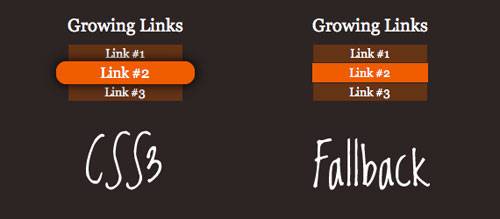
CSS3 can do some seriously neat stuff. Just check out some of the crazy 3D stuff you can do in WebKit. But as we all know, we need to be careful with what we choose to do with it. The most cutting edge techniques are fun to play with, but since since only a sliver of browsers support them fully, we can only use them in circumstances where they fall back to otherwise perfectly acceptable styling. Let’s look at a couple of quick, simple, cheezy examples.

CSS3 can do some seriously neat stuff. Just check out some of the crazy 3D stuff you can do in WebKit. But as we all know, we need to be careful with what we choose to do with it. The most cutting edge techniques are fun to play with, but since since only a sliver of browsers support them fully, we can only use them in circumstances where they fall back to otherwise perfectly acceptable styling. Let’s look at a couple of quick, simple, cheezy examples.
Create a Beautiful Looking Custom Dialog Box With jQuery and CSS3

This custom dialog box is one of the scripts in that website and I think it will be quite useful for all of you as well. The reason I have this custom dialog box is due to the inconsistencies across different browsers. If you look at mac’s firefox and windows’ firefox, the dialog box is completely different!

This custom dialog box is one of the scripts in that website and I think it will be quite useful for all of you as well. The reason I have this custom dialog box is due to the inconsistencies across different browsers. If you look at mac’s firefox and windows’ firefox, the dialog box is completely different!
Easily Turn Your Images Into Polaroids with CSS3
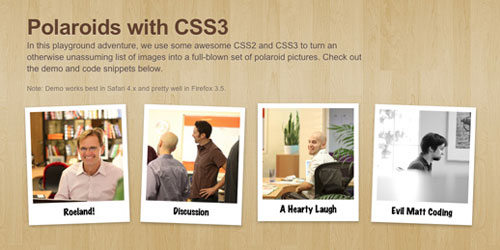
Yesterday, Jon and I were going back and forth about what to blog about next. Love of CSS and doing something cool with it is kind of our thing and we quickly jumped on a brand new idea: polaroid style images with just CSS. Holy super awesome, Batman!

Yesterday, Jon and I were going back and forth about what to blog about next. Love of CSS and doing something cool with it is kind of our thing and we quickly jumped on a brand new idea: polaroid style images with just CSS. Holy super awesome, Batman!
How to Build a Lava-Lamp Style Navigation Menu

A couple weeks ago, I created a screencast that demonstrated how to build a three-level navigation menu. In a response email, one of our readers requested a tutorial on how to build a lava-lamp style menu. Luckily, it’s quite a simple task, especially when using a JavaScript library. We’ll build one from scratch today.

A couple weeks ago, I created a screencast that demonstrated how to build a three-level navigation menu. In a response email, one of our readers requested a tutorial on how to build a lava-lamp style menu. Luckily, it’s quite a simple task, especially when using a JavaScript library. We’ll build one from scratch today.
ShineTime – A Kick-Ass New jQuery & CSS3 Gallery With Animated Shine Effects
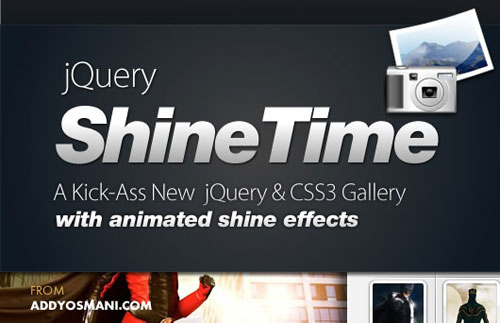
This week I’d like to show you how you can create a kick-ass animated Shine Effect with jQuery & CSS3 and then use it to create your very own Shiny Gallery ‘ShineTime’. This effect is useful in making your user interface elements look like they’re a real polaroid photo (or made of glass) and the best part is, it’s not that difficult to achieve.

This week I’d like to show you how you can create a kick-ass animated Shine Effect with jQuery & CSS3 and then use it to create your very own Shiny Gallery ‘ShineTime’. This effect is useful in making your user interface elements look like they’re a real polaroid photo (or made of glass) and the best part is, it’s not that difficult to achieve.
Quick Tip: Understanding CSS3 Gradients
Creating an image only for the purpose of displaying a gradient is inflexible, and is quickly becoming a bad practice. Unfortunately, at the time of this writing, they very well might still be required, but hopefully not for much longer. Thanks to Firefox and Safari/Chrome, we can now create powerful gradients with minimal effort. In this video quick tip, we’ll examine some of the differences in syntax when working with the -moz and -webkit vendor prefixes.
Creating an image only for the purpose of displaying a gradient is inflexible, and is quickly becoming a bad practice. Unfortunately, at the time of this writing, they very well might still be required, but hopefully not for much longer. Thanks to Firefox and Safari/Chrome, we can now create powerful gradients with minimal effort. In this video quick tip, we’ll examine some of the differences in syntax when working with the -moz and -webkit vendor prefixes.
Code a Backwards Compatible, One Page Portfolio with HTML5 and CSS3

HTML5 is the future of web development but believe it or not you can start using it today. HTML5 is much more considerate to semantics and accessibility as we don’t have to throw meaningless div’s everywhere. It introduces meaningful tags for common elements such as navigations and footers which makes much more sense and are more natural.

HTML5 is the future of web development but believe it or not you can start using it today. HTML5 is much more considerate to semantics and accessibility as we don’t have to throw meaningless div’s everywhere. It introduces meaningful tags for common elements such as navigations and footers which makes much more sense and are more natural.
How To Create A Sexy Vertical Sliding Panel Using jQuery And CSS3
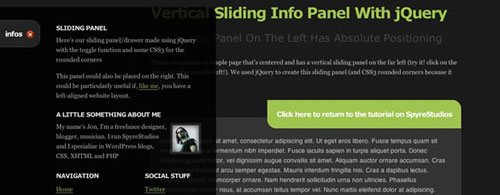
More and more we see people using horizontal sliding panels on their websites. And they usually look very nice! Some will put a contact or login form in there, others will put some information about them and their website, or even things like a tag cloud or social networking buttons.

More and more we see people using horizontal sliding panels on their websites. And they usually look very nice! Some will put a contact or login form in there, others will put some information about them and their website, or even things like a tag cloud or social networking buttons.
Create a Cool Messy List with CSS3 and nth-child
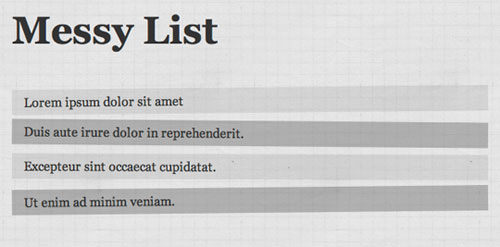
While working on a design recently, I stumbled upon Chris Coyier’s article How nth-child Works. Chris shows us the basics of the nth-child pseudo-selector in CSS. It can be used for so many things, but in this short tutorial I’m going to show you how to create a cool messy list.

While working on a design recently, I stumbled upon Chris Coyier’s article How nth-child Works. Chris shows us the basics of the nth-child pseudo-selector in CSS. It can be used for so many things, but in this short tutorial I’m going to show you how to create a cool messy list.
Design a Prettier Web Form with CSS 3

Thanks to advanced CSS properties, such as gradients and shadows, it’s now quite easy to turn a dull web form into something beautiful – with minimal effort

Thanks to advanced CSS properties, such as gradients and shadows, it’s now quite easy to turn a dull web form into something beautiful – with minimal effort
CSS3 Linear Gradients
With the advent of CSS3′s comes support for gradients, specifically, linear and radial gradients. CSS Gradients is supported in FF3.6+, Safari 2+ and Google Chrome. In FF3.6, gradients can currently only be applied to an element’s “background-image” or shorthand “background” properties.
With the advent of CSS3′s comes support for gradients, specifically, linear and radial gradients. CSS Gradients is supported in FF3.6+, Safari 2+ and Google Chrome. In FF3.6, gradients can currently only be applied to an element’s “background-image” or shorthand “background” properties.
CSS Fundamentals: CSS 3 Transitions
As CSS3 rolls out around the web, it is bringing some interesting new presentational techniques along with it. Today, we’ll review the basics of using CSS3 transitions and animations to add an extra layer of polish.
As CSS3 rolls out around the web, it is bringing some interesting new presentational techniques along with it. Today, we’ll review the basics of using CSS3 transitions and animations to add an extra layer of polish.
Beautiful Nag Screen using Mootools & CSS3

Nagscreen : Messages on the webpage that reminds (or nags) the user to register, or show some notification. These messages appear on the webpage in a way to seek user attention. Here in this post we’ll be creating beautiful and dynamic Nag Screen using Mootools.

Nagscreen : Messages on the webpage that reminds (or nags) the user to register, or show some notification. These messages appear on the webpage in a way to seek user attention. Here in this post we’ll be creating beautiful and dynamic Nag Screen using Mootools.
Object-Oriented CSS: What, How, and Why
It sounds like an oxymoron, or at least an impossibility, doesn’t it? How can a static language that’s really more like markup than programming be object-oriented? In this tutorial, I’m going to introduce you to the idea of object-oriented CSS, show you how it works, and try to convince you that you should be using it too!
It sounds like an oxymoron, or at least an impossibility, doesn’t it? How can a static language that’s really more like markup than programming be object-oriented? In this tutorial, I’m going to introduce you to the idea of object-oriented CSS, show you how it works, and try to convince you that you should be using it too!
A Crash-Course in Advanced CSS3 Effects
Webkit is one of the few – if only – browser engines that really embraces advanced CSS3 effects. Unfortunately, this presents somewhat of a double-edged sword. We get to play with all of these amazing effects – such as CSS masks, reflections, transitions, animations, scaling, etc. – yet, we can’t truly implement them into our projects until more browsers provide support. With all of that said, it’s important to be on the cutting edge of what’s possible.
Webkit is one of the few – if only – browser engines that really embraces advanced CSS3 effects. Unfortunately, this presents somewhat of a double-edged sword. We get to play with all of these amazing effects – such as CSS masks, reflections, transitions, animations, scaling, etc. – yet, we can’t truly implement them into our projects until more browsers provide support. With all of that said, it’s important to be on the cutting edge of what’s possible.
Stronger, Better, Faster Design with CSS3
In this second article we’re going to focus on using those CSS techniques (and a little JavaScript) to create some practical elements and layouts. As before, caveat coder — a lot of the CSS properties we’re going to use have limited support, if any, in IE6/7 and probably 8. Firefox 3.5+ and Safari 4 are your best bet right now to see all the cool stuff going on in CSS right now (Chrome does a pretty good job, too).
In this second article we’re going to focus on using those CSS techniques (and a little JavaScript) to create some practical elements and layouts. As before, caveat coder — a lot of the CSS properties we’re going to use have limited support, if any, in IE6/7 and probably 8. Firefox 3.5+ and Safari 4 are your best bet right now to see all the cool stuff going on in CSS right now (Chrome does a pretty good job, too).
Take Your Design To The Next Level With CSS3
It’s time to introduce CSS3 features into our projects and not be afraid to gradually incorporate CSS3 properties and selectors in our style sheets. Making our clients aware of the advantages of CSS3 (and letting older deprecated browsers fade away) is in our power, and we should act on it, especially if it means making websites more flexible and reducing development and maintenance costs.
It’s time to introduce CSS3 features into our projects and not be afraid to gradually incorporate CSS3 properties and selectors in our style sheets. Making our clients aware of the advantages of CSS3 (and letting older deprecated browsers fade away) is in our power, and we should act on it, especially if it means making websites more flexible and reducing development and maintenance costs.
In this article, we’ll look at the advantages of CSS3 and some examples of how Web designers are already using it. By the end, we’ll know a bit of what to expect from CSS3 and how we can use its new features in our projects.
11 Classic CSS Techniques Made Simple with CSS3
We’ve all had to achieve some effect that required an extra handful of divs or PNGs. We shouldn’t be limited to these old techniques when there’s a new age coming. This new age includes the use of CSS3. In today’s tutorial, I’ll show you eleven different time-consuming effects that can be achieved quite easily with CSS3.
We’ve all had to achieve some effect that required an extra handful of divs or PNGs. We shouldn’t be limited to these old techniques when there’s a new age coming. This new age includes the use of CSS3. In today’s tutorial, I’ll show you eleven different time-consuming effects that can be achieved quite easily with CSS3.
5 Techniques to Acquaint You With CSS 3
CSS is a well-known, widely used language to style websites. With version three in the works, many time-saving features will be implemented. Although only the most modern browsers currently support these effects, it’s still fun to see what’s around the corner! In this tutorial I’ll show you five techniques.
CSS is a well-known, widely used language to style websites. With version three in the works, many time-saving features will be implemented. Although only the most modern browsers currently support these effects, it’s still fun to see what’s around the corner! In this tutorial I’ll show you five techniques.
CSS 3 Cheat Sheet (PDF)
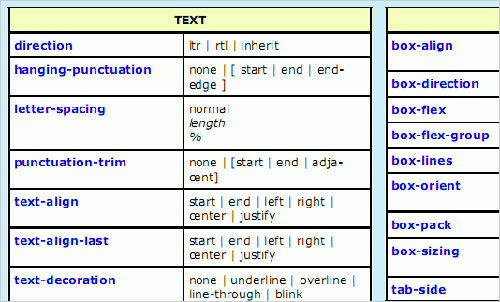
In this post we present a printable CSS 3 Cheat Sheet (PDF), a complete listing of all the properties, selectors types and allowed values in the current CSS 3 specification from the W3C. Each property is provided in a section that attempts to match it with the section (module) that it is most actively associated within the W3C specification. Next to each property is a listing of the expected values that that property takes (normal text shows named values it accepts and italics shows value types it will accept).

In this post we present a printable CSS 3 Cheat Sheet (PDF), a complete listing of all the properties, selectors types and allowed values in the current CSS 3 specification from the W3C. Each property is provided in a section that attempts to match it with the section (module) that it is most actively associated within the W3C specification. Next to each property is a listing of the expected values that that property takes (normal text shows named values it accepts and italics shows value types it will accept).
HTML 5 and CSS 3: The Techniques You’ll Soon Be Using
In this tutorial, we are going to build a blog page using next-generation techniques from HTML 5 and CSS 3. The tutorial aims to demonstrate how we will be building websites when the specifications are finalized and the browser vendors have implemented them. If you already know HTML and CSS, it should be easy to follow along.
In this tutorial, we are going to build a blog page using next-generation techniques from HTML 5 and CSS 3. The tutorial aims to demonstrate how we will be building websites when the specifications are finalized and the browser vendors have implemented them. If you already know HTML and CSS, it should be easy to follow along.
The New Hotness: Using CSS3 Visual Effects
Not everything in this article is practical, or even bug-free, but it’s a fun primer on what’s in the pipeline for Web design. To get the most from these examples, you’ll have to use Safari 4 or Chrome. (Firefox 3.5 can handle most of it, but not everything: WebKit is further along than Gecko in its tentative CSS support.) We’ll show you how to create impressive image galleries, build animated music players and overlay images like a pro. All set? Let’s rock.
Not everything in this article is practical, or even bug-free, but it’s a fun primer on what’s in the pipeline for Web design. To get the most from these examples, you’ll have to use Safari 4 or Chrome. (Firefox 3.5 can handle most of it, but not everything: WebKit is further along than Gecko in its tentative CSS support.) We’ll show you how to create impressive image galleries, build animated music players and overlay images like a pro. All set? Let’s rock.
How To Create Depth And Nice 3D Ribbons Only Using CSS3
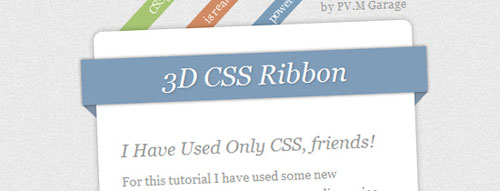
This is a widespread trends in recent web design: creating a 3D perception in a website and simulating a “world” in three dimensions are two great ways for the designers to play with their skills.

This is a widespread trends in recent web design: creating a 3D perception in a website and simulating a “world” in three dimensions are two great ways for the designers to play with their skills.
Experimental: Pure CSS social media icons
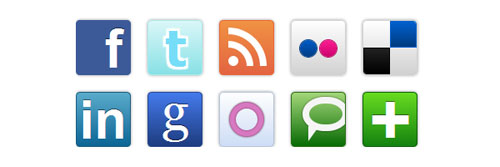
This is an experiment that creates social media icons using CSS and semantic HTML. It uses progressive enhancement to turn an unordered list of text links into a set of icons without the use of images or JavaScript.
This is an experiment that creates social media icons using CSS and semantic HTML. It uses progressive enhancement to turn an unordered list of text links into a set of icons without the use of images or JavaScript.
Rounded corner HTML elements using CSS3
This is a behavior htc file for Internet explorer to make CSS property ” border-radius ” work on all browsers. At present, all major browsers other than IE shows curved corner by adding 4 lines of css
This is a behavior htc file for Internet explorer to make CSS property ” border-radius ” work on all browsers. At present, all major browsers other than IE shows curved corner by adding 4 lines of css
Speed Up with CSS3 Gradients
WebKit browsers paved the way with CSS based gradients. Now Firefox 3.6 is out and is supporting them as well, which makes using them for progressive enhancement all the more appealing. More good news, CSS3 gradients fall into the camp where you can specify fallbacks (i.e. images) so that browsers that don’t support them just use the image instead.
WebKit browsers paved the way with CSS based gradients. Now Firefox 3.6 is out and is supporting them as well, which makes using them for progressive enhancement all the more appealing. More good news, CSS3 gradients fall into the camp where you can specify fallbacks (i.e. images) so that browsers that don’t support them just use the image instead.
How to Dynamically Highlight Content Like Wikipedia Using CSS3

If you’ve ever clicked on a footnote link in a Wikipedia article, you’ve probably noticed that two things happen: (1) the link brings you to the footnote section at the bottom of the page; and (2) the selected footnote is highlighted with a different color. In a list of footnotes, this feature makes it easy for the reader to visually access the appropriate footnote.

If you’ve ever clicked on a footnote link in a Wikipedia article, you’ve probably noticed that two things happen: (1) the link brings you to the footnote section at the bottom of the page; and (2) the selected footnote is highlighted with a different color. In a list of footnotes, this feature makes it easy for the reader to visually access the appropriate footnote.
Old School Clock with CSS3 and jQuery

Transform:rotate is a new feature of CSS 3 which lets you… well, rotate stuff. Transform will also allow you to scale, skew and translate (move) objects in your web page. All these can be animated by the Transition property (complete with easing and duration).

Transform:rotate is a new feature of CSS 3 which lets you… well, rotate stuff. Transform will also allow you to scale, skew and translate (move) objects in your web page. All these can be animated by the Transition property (complete with easing and duration).
CSS3 support for Internet Explorer 6, 7, and 8
IE-CSS3 is a script to provide Internet Explorer support for several of the popular new styles available in the upcoming CSS3 standard.
IE-CSS3 is a script to provide Internet Explorer support for several of the popular new styles available in the upcoming CSS3 standard.
Progressive enhancement: pure CSS speech bubbles
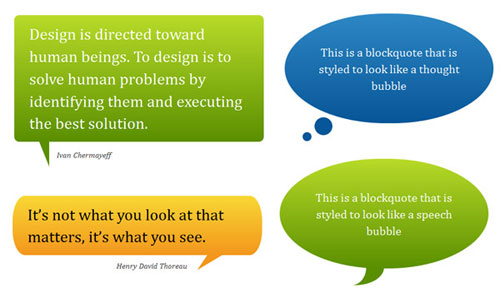
Speech bubbles are a popular effect but many tutorials rely on presentational HTML or JavaScript. This tutorial contains various forms of speech bubble effect created with CSS2.1 and enhanced with CSS3. No images, no JavaScript and it can be applied to your existing semantic HTML.

Speech bubbles are a popular effect but many tutorials rely on presentational HTML or JavaScript. This tutorial contains various forms of speech bubble effect created with CSS2.1 and enhanced with CSS3. No images, no JavaScript and it can be applied to your existing semantic HTML.
Creating a Realistic Looking Button with CSS3
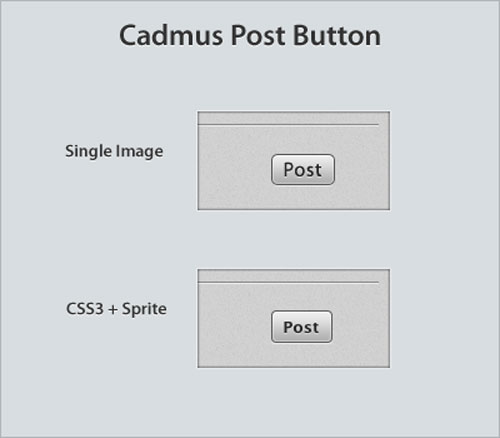
I had previously created the Cadmus “post” button in Photoshop and it was essentially three images for the different states. I wanted to use this style for all our buttons, but doing it with single images is not a good idea. So I set about creating the same style of the buttons with CSS3

I had previously created the Cadmus “post” button in Photoshop and it was essentially three images for the different states. I wanted to use this style for all our buttons, but doing it with single images is not a good idea. So I set about creating the same style of the buttons with CSS3
Creating Pie Charts with CSS3
Keep in mind that this technique is currently cutting-edge. It only works in the latest versions of Firefox, Chrome,and Safari UPDATE and Opera; and requires browser-specific extensions to CSS to pull off, but it does use elements in the current CSS3 specification, so it stands that eventually the rest of the web will catch up.
Keep in mind that this technique is currently cutting-edge. It only works in the latest versions of Firefox, Chrome,and Safari UPDATE and Opera; and requires browser-specific extensions to CSS to pull off, but it does use elements in the current CSS3 specification, so it stands that eventually the rest of the web will catch up.
CSS3 Techniques You Should Know
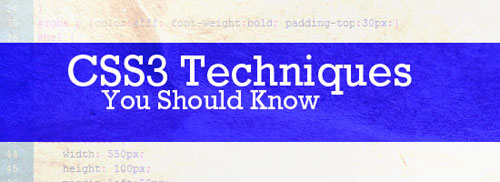
Many of you have probably heard all the buzz around CSS3, but exactly which techniques can we use today? In this article I’ll show you some different CSS3 techniques that work great in some of the leading browsers (i.e. Firefox, Chrome, Safari, Opera ), and how they will degrade well in the non-supported browsers (i.e. Internet Explorer). Using browser specific extensions, many of the proposed CSS3 styles can be used today!

Many of you have probably heard all the buzz around CSS3, but exactly which techniques can we use today? In this article I’ll show you some different CSS3 techniques that work great in some of the leading browsers (i.e. Firefox, Chrome, Safari, Opera ), and how they will degrade well in the non-supported browsers (i.e. Internet Explorer). Using browser specific extensions, many of the proposed CSS3 styles can be used today!
The hidden power of border-radius
So hopefully after reading – Understanding CSS – Padding, Positioning and CSS3 – you understand the basics of CSS and have been experimenting with other properties. It is important to remember that some properties will allow you to achieve effects that aren’t necessarily stated. In this post we will explore the property border-radius and how it can be used to create circles, semi-cricles and quarter-circles. It also has the potential to produce some terrific designs using just CSS – no images.
So hopefully after reading – Understanding CSS – Padding, Positioning and CSS3 – you understand the basics of CSS and have been experimenting with other properties. It is important to remember that some properties will allow you to achieve effects that aren’t necessarily stated. In this post we will explore the property border-radius and how it can be used to create circles, semi-cricles and quarter-circles. It also has the potential to produce some terrific designs using just CSS – no images.
Multiple Backgrounds and CSS Gradients
CSS3 features are making their way into the various browsers and while many are holding off on implementing them, there are those who are venturing ahead and likely running into a world of interesting quirks across the various platforms.
CSS3 features are making their way into the various browsers and while many are holding off on implementing them, there are those who are venturing ahead and likely running into a world of interesting quirks across the various platforms.
Two such features that I have been having the pleasure of enjoying are the use of multiple backgrounds and CSS gradients. I’m covering both features because multiple backgrounds by itself is simple enough, as are CSS gradients, but combining the two is where things get interesting.
The Mysterious Pseudo Class in CSS

Pseudo classes are those things with colons in them, you know, like :hover or :link. They let you control the CSS of stuff in different forms, states and places easily and efficiently, without taking up too much room. CSS3 is going to introduce a ton of new pseudo classes, and they’re going to make our lives a lot easier (if you take browser compatibility out of the equation). They help both aesthetics and usability, and can make things that were once hard easier than ever before.

Pseudo classes are those things with colons in them, you know, like :hover or :link. They let you control the CSS of stuff in different forms, states and places easily and efficiently, without taking up too much room. CSS3 is going to introduce a ton of new pseudo classes, and they’re going to make our lives a lot easier (if you take browser compatibility out of the equation). They help both aesthetics and usability, and can make things that were once hard easier than ever before.
Nice And Simple Toolbar For Your Website With CSS3 And jQuery

Our goal is to realize a fixed panel, on the bottom of the page, to improve interaction with our users.
Well, below you can see my idea in “visible status” (I’ve designed it using Photoshop). In this post we’ll use some basic techniques to realize the panel, after the reading only your fantasy could be a limit to enhance the toolbar for you purposes.

Our goal is to realize a fixed panel, on the bottom of the page, to improve interaction with our users.
Well, below you can see my idea in “visible status” (I’ve designed it using Photoshop). In this post we’ll use some basic techniques to realize the panel, after the reading only your fantasy could be a limit to enhance the toolbar for you purposes.
jQuery DJ Hero – CSS3 and jQuery fun
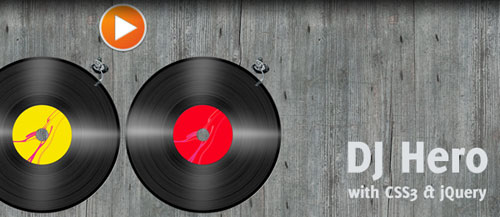
By combining CSS3 and jQuery, I created two records that you can start spinning (faster and slower) and even scratching is enabled. In a future version, this could be used together with some real sound (this version has no sound).

By combining CSS3 and jQuery, I created two records that you can start spinning (faster and slower) and even scratching is enabled. In a future version, this could be used together with some real sound (this version has no sound).
CSS3 Color Names
Color names also known as color keywords, named colors and named color keywords in which their is 147 color names that are defined in the CSS3 color specification. Now the 147 color names also include the 17 standard color names. All 147 color names where taken from the X Windows Systems, X color names, which has been in use for many and I mean many years. So the 147 color names even though they are not the standard are likely to be very well supported.
Color names also known as color keywords, named colors and named color keywords in which their is 147 color names that are defined in the CSS3 color specification. Now the 147 color names also include the 17 standard color names. All 147 color names where taken from the X Windows Systems, X color names, which has been in use for many and I mean many years. So the 147 color names even though they are not the standard are likely to be very well supported.
CSS Trick: Hidden Messages
Here’s a cool little CSS 3 trick for hiding messages within your text. We’re going to be using the ::selection declaration to change the colour of the text on selection. The ::selection declaration is a new tool used in CSS 3, but currently isn’t supported by Internet Explorer.
Here’s a cool little CSS 3 trick for hiding messages within your text. We’re going to be using the ::selection declaration to change the colour of the text on selection. The ::selection declaration is a new tool used in CSS 3, but currently isn’t supported by Internet Explorer.
Transition Timing Functions
This article follows on from the related article on Animation using CSS Transforms and investigates the transition-duration and transition-timing-function properties which control, respectively, the duration and speed at which a transition is carried out.
As before, the examples on this page will currently only work if you download a WebKit Nightly Build web browser.
This article follows on from the related article on Animation using CSS Transforms and investigates the transition-duration and transition-timing-function properties which control, respectively, the duration and speed at which a transition is carried out.
As before, the examples on this page will currently only work if you download a WebKit Nightly Build web browser.
23 Essential HTML 5 Resources
Everyone is excited about the possibilities of HTML 5, but there’s a lot to learn and absorb as well
Everyone is excited about the possibilities of HTML 5, but there’s a lot to learn and absorb as well
Preparing for HTML5 with Semantic Class Names
This is a brief introduction to the new structural elements in the HTML 5 Working Draft, and how to use semantic class names in HTML 4.01 or XHTML 1.0 markup that correspond to the names of those structural elements. By doing so, you’ll get a head start in understanding how to use the new elements and also go some way towards using plain old semantic HTML if you’re not already.
This is a brief introduction to the new structural elements in the HTML 5 Working Draft, and how to use semantic class names in HTML 4.01 or XHTML 1.0 markup that correspond to the names of those structural elements. By doing so, you’ll get a head start in understanding how to use the new elements and also go some way towards using plain old semantic HTML if you’re not already.
Use CSS3 to create a set of columns on your website without having to assign individual layers and / or paragraphs for each column.
Along with multiple background images, this following piece of CSS3 is among my favourites list. I think there is a lot of great potential for this CSS and in ways more than just a news paper/magazine layouts too!
Along with multiple background images, this following piece of CSS3 is among my favourites list. I think there is a lot of great potential for this CSS and in ways more than just a news paper/magazine layouts too!
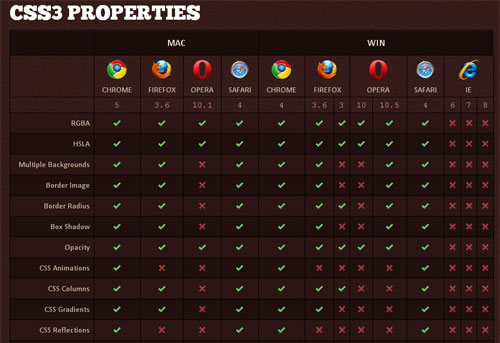
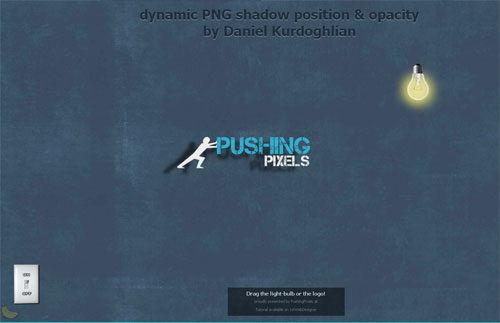
0 Comment to "All There Is To Know About HTML5 and CSS3"
Post a Comment